no knead dutch oven bread
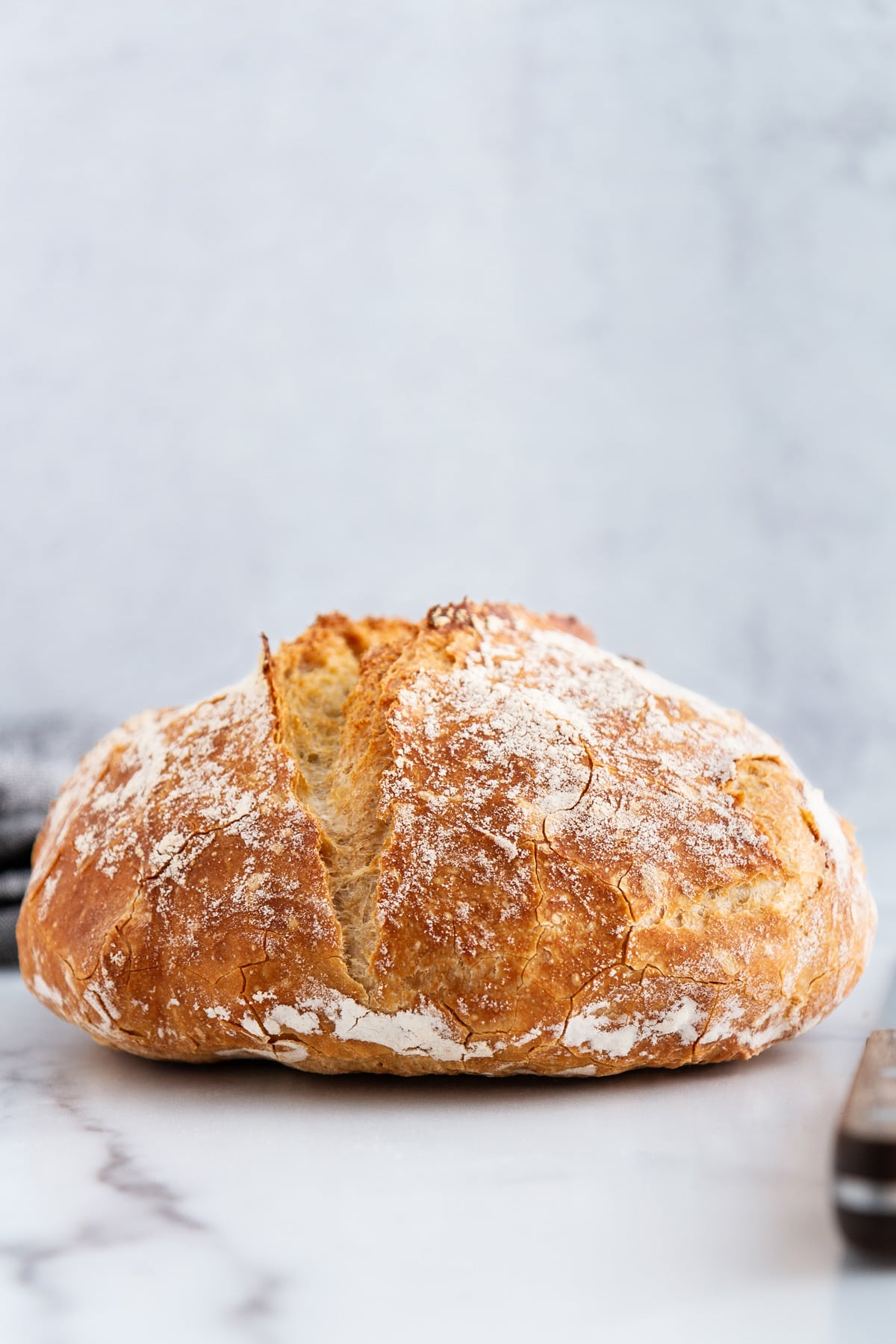
Ready to bake homemade bread in your own kitchen? This no knead Dutch oven bread is your BFF. You just need three ingredients to make this delicious recipe, and I’ll take you through it step by step. So, what are you waiting for? It’s time to get some delicious carbs in your life.
No Knead Dutch Oven Bread Recipe
If you could see me right now, you’d know I am jumping for joy for this post.
Why?
Because this beautiful loaf — this glorious no knead Dutch oven bread — might just be the very best bread I’ve ever baked. Seriously. And it also happens to be one of the easiest ever, too. And I’m going to show you, step by step, just how to do it.
Like I said, so much jumping for joy. And for carbs.
First things first: The reason I believe this may be the very best bread I’ve ever baked (the method for which, by the way, originated from the great Jim Lahey of Sullivan Street Bakery) is three-fold:
- One, the taste. It’s just amazing. It’s slightly salty and not at all boring, like some basic breads tend to be.
- Two, the texture. It’s mega-soft on the inside but with a light, tender, almost flaky crust on the outside. And the air pockets in the bread slices just slay me. You’ll soon see what I mean. AND YOU WILL LOVE IT.
- And three, the preparation. This recipe couldn’t be simpler: As in, you stir a few ingredients together, let them sit overnight, and the next morning, you bake a loaf of bread. DONE. No, I’m not joking. Yes, you need to drop everything and make this bread right now. So let’s get to it!
How to Make No Knead Dutch Oven Bread Dough
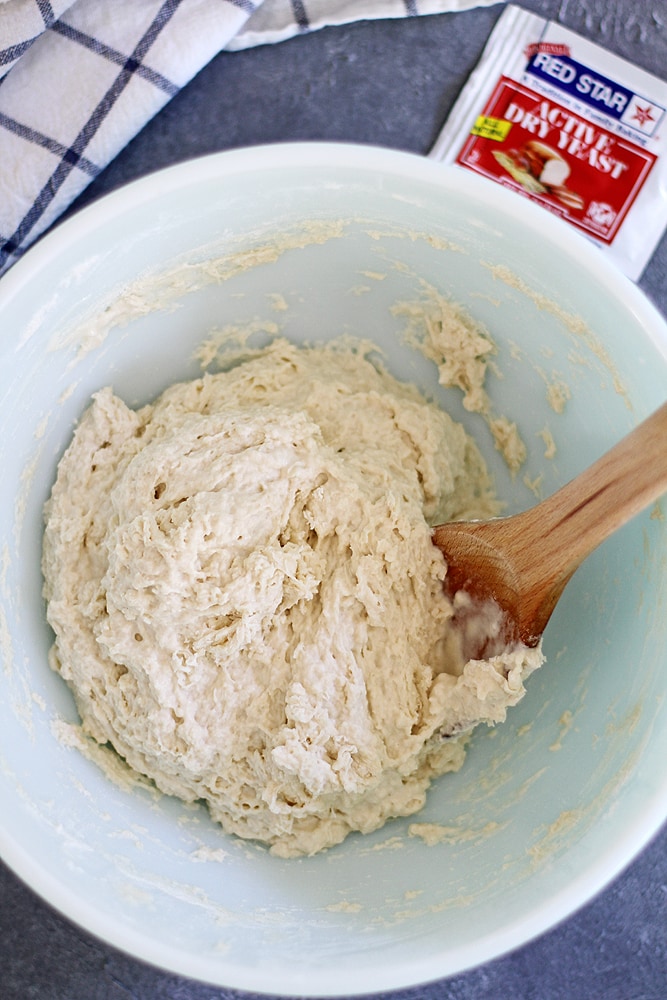
Let’s keep this sweet and simple, shall we? Here is how you make this dough:
- First, in a large bowl, whisk together flour, salt and yeast (I used my go-to Red Star active dry yeast) until well mixed. Pour in warm water (about 110 to 115 degrees F, or just slightly warmer than lukewarm) and use a wooden spoon to stir the mixture until it forms a wet, sticky and shaggy dough. That’s it! No kneading, no nothing.
- Next, cover the bowl with plastic wrap and let the dough rise for at least 8 hours (but no more than around 18 hours).
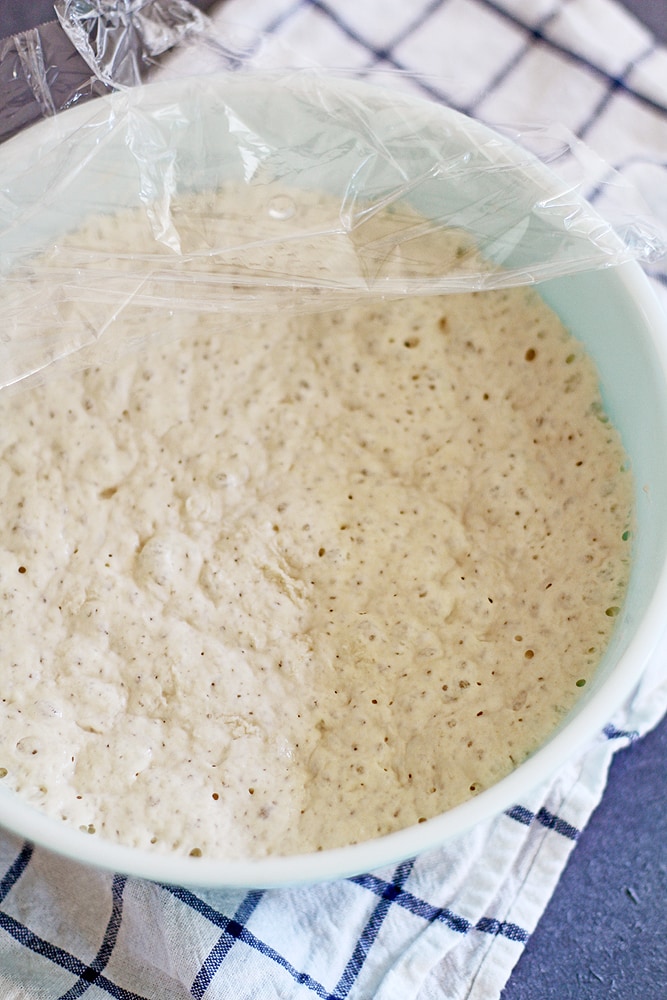
- When the dough is fully risen, it should be more than doubled in size, bubbly and flattened on top. That means it’s ready for baking! Yes, already. No, it won’t be difficult.
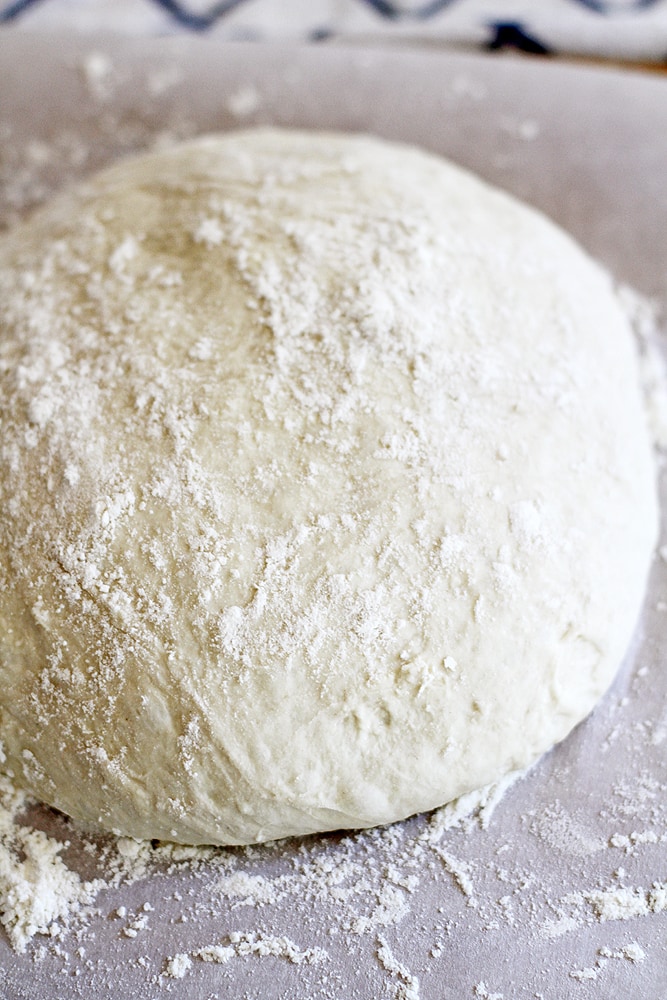
- Heat your oven to 450 degrees F, and place a covered Dutch oven on the center rack to preheat for about 30 minutes (I used a 6-quart Dutch oven, but even a 4-quart or 8-quart Dutch oven would work).
- Meanwhile, punch down the dough and, using very well-floured hands (the dough is pretty sticky, remember!), transfer the dough to a well-floured sheet of parchment paper. Shape the dough into a ball and sprinkle the top lightly with more flour.
- Cover the dough with a sheet of plastic wrap and let it rest for 30 minutes.
Watch How to Make This Recipe
[adthrive-in-post-video-player video-id=”2ohuJ1Q3″ upload-date=”2023-02-19T19:07:27.000Z” name=”No-Knead Dutch Oven Bread” description=”This no-knead Dutch oven bread is about to be your new favorite homemade bread recipe! Just three ingredients are all you need to make this magical, miraculous bread from scratch in your own kitchen.” player-type=”default” override-embed=”default”]
How to Bake No Knead Dutch Oven Bread
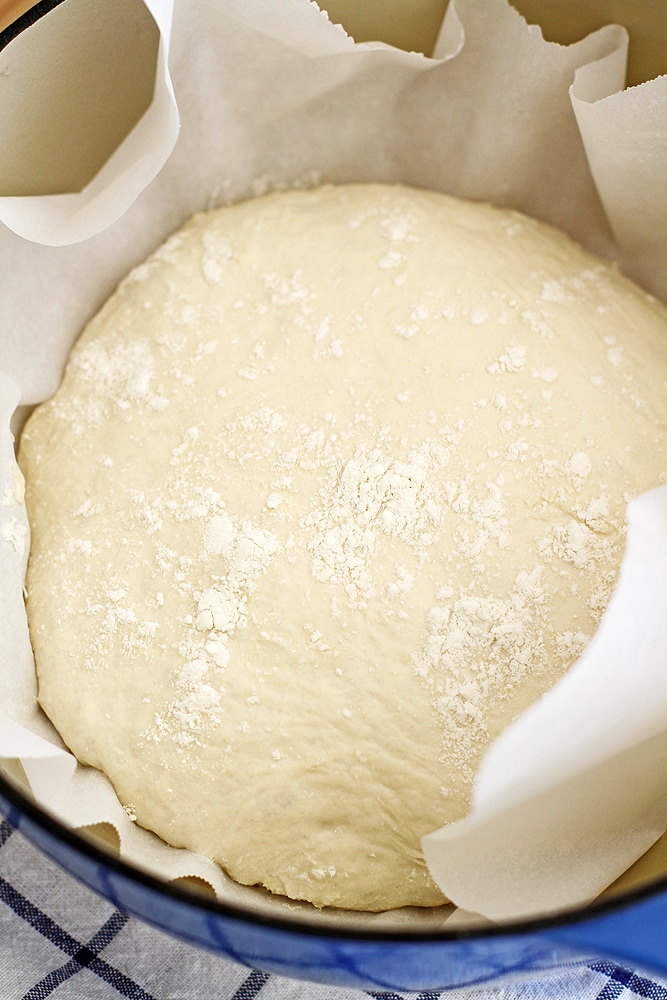
Let’s talk about the bake!
- When the dough is fully rested, remove the Dutch oven from the oven (careful, it’s insanely hot!) and either transfer the dough alone directly to the Dutch oven, or place it in the Dutch oven with the parchment paper underneath. If the bottom of your Dutch oven isn’t enamel-coated, it’s best to use the parchment paper. Mine is enamel-coated, but I find it easier to keep the round shape of the dough if I just place it in the Dutch oven with the parchment paper. Whatever works fer ya!
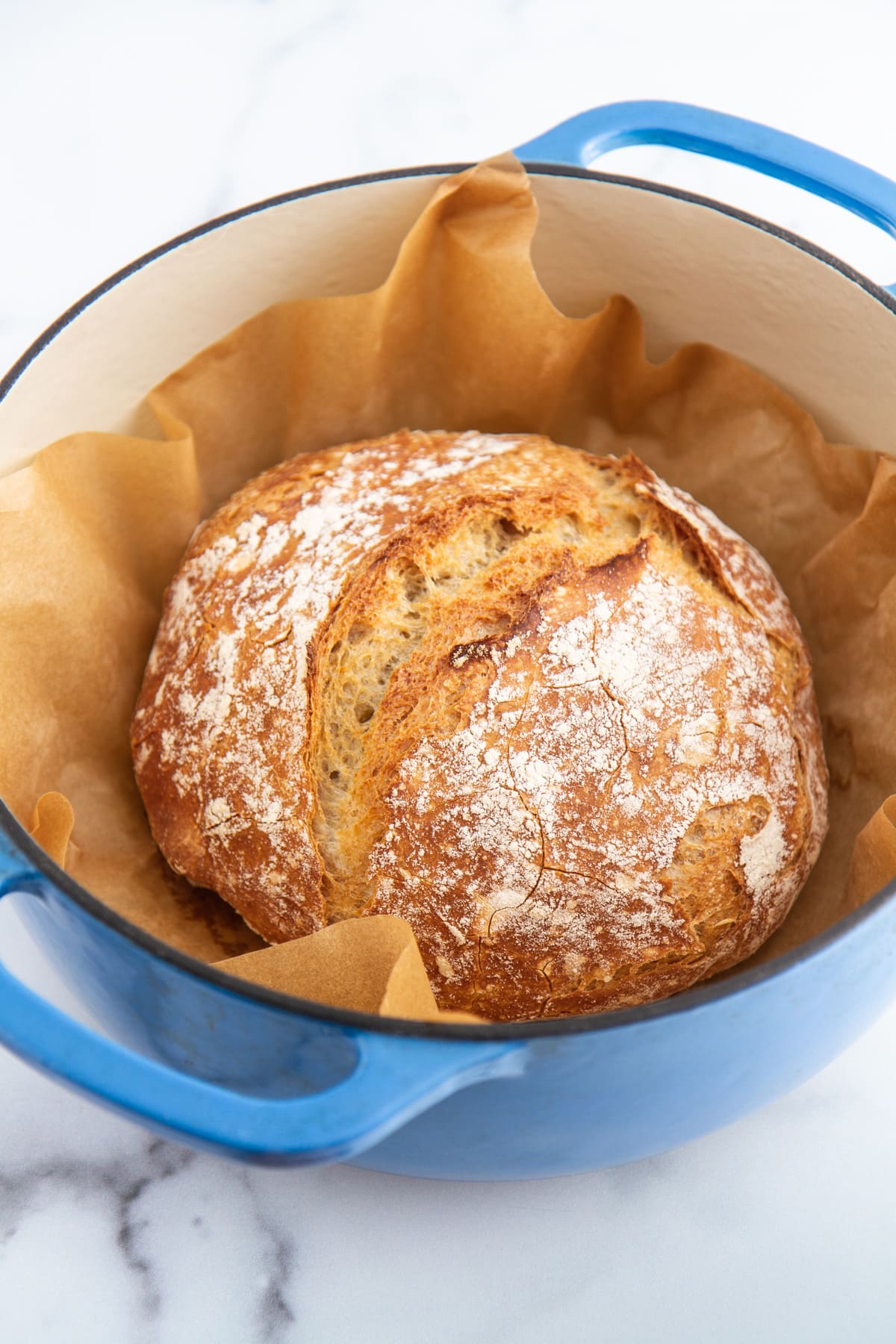
- Cover the Dutch oven and return it to the oven (how many times can I type the word “oven”?). Bake the dough 45 minutes covered, then another 10 to 15 minutes uncovered until the top of the bread is a lovely golden brown.
Can you believe it? YOU BAKED THAT. And you barely had to do anything.
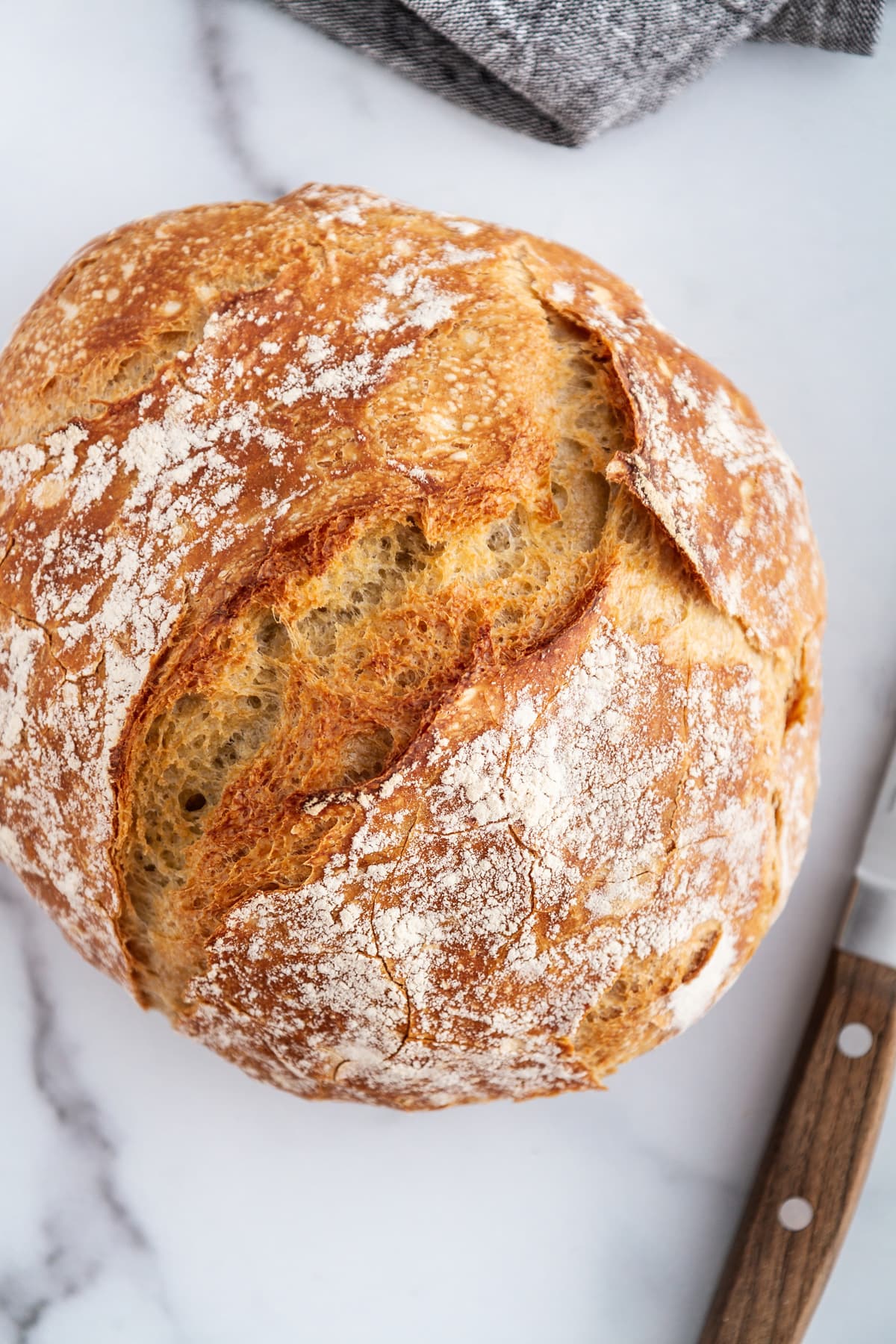
Let the bread cool for just a few minutes — basically until you can handle it without burning your fingerprints off — and then slice away.
How to Enjoy No-Knead Dutch Oven Bread
Suggestions for how to enjoy no-knead Dutch oven bread: As grilled cheese, dipped in soup, as garlic bread, spread with peanut butter (and jelly!), cut up into croutons, ripped apart and shoved right into face, etc. etc. I have done/will do all of the above.
Of course, if you also need someone to come over and assist you in eating all of this gorgeous and delicious loaf of bread you just baked, I’m your leading lady. But if you’re anything like me, I have a feeling you won’t need any help.
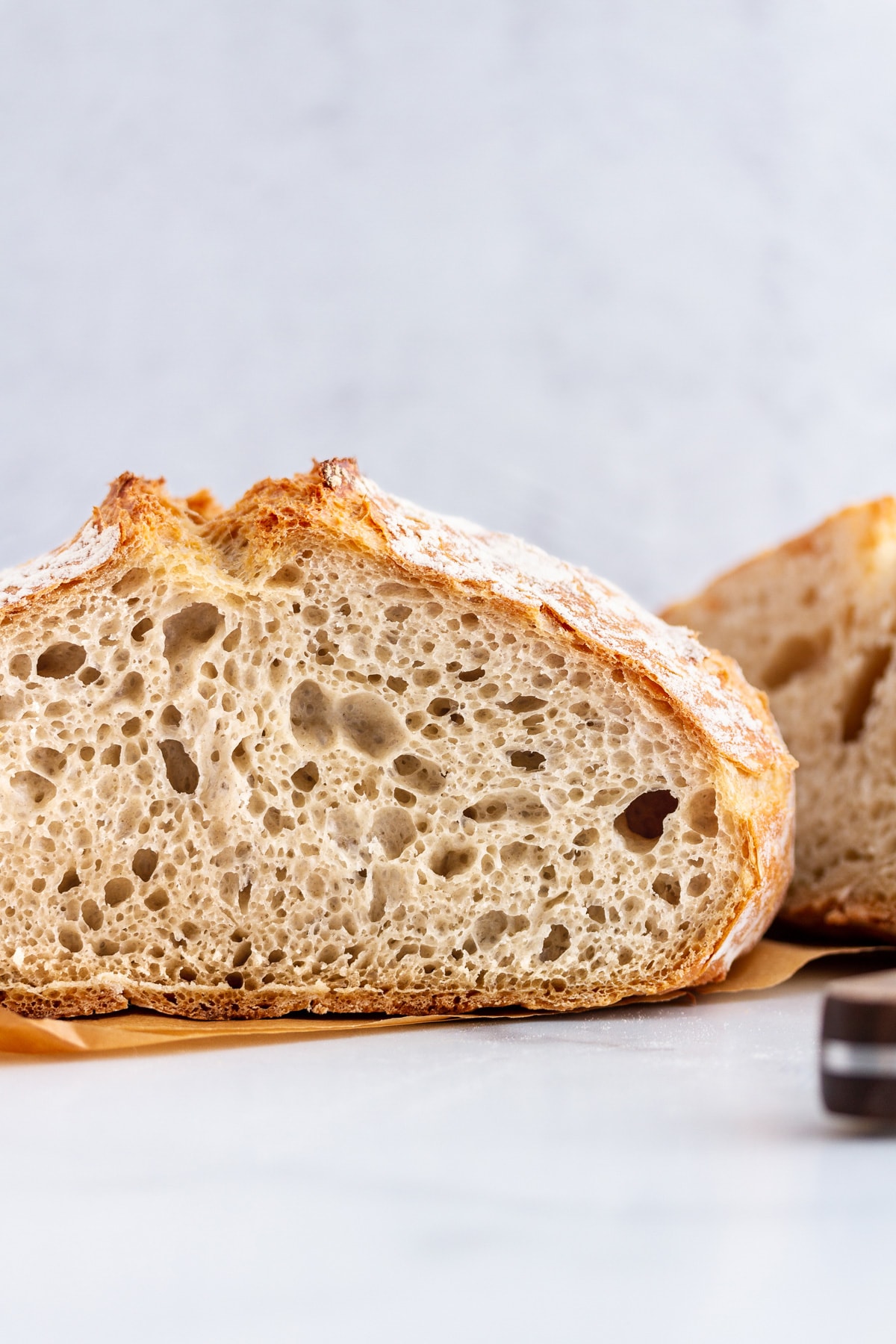
Uhhhhhhhhhh those air pockets, AMIRIGHT?
P.S. Ready for your next bread baking adventure? Try my Sourdough 101 series, which takes you step by step through the entire process of making homemade sourdough at home, from starter to loaf. Check ou this Banana Bread Recipe for my other favorite bread!
More Delicious Bread Recipes
- rosemary-garlic no-knead bread
- no knead ciabatta bread
- classic brioche loaf bread
- classic italian bread
- cinnamon raisin sourdough bread
- whole wheat bread
- potato bread
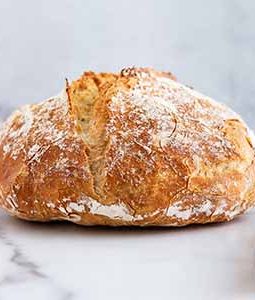
No-Knead Dutch Oven Bread
- Prep Time: 1 hour 10 mins (plus 8 hours rise time)
- Cook Time: 1 hour
- Total Time: 2 hours 10 minutes
- Yield: 1 loaf 1x
- Category: Bread
- Method: Bake
- Cuisine: American
Description
This no-knead Dutch oven bread is the easiest bread you’ll ever bake! No kneading, no fuss, just delicious carbs.
Ingredients
- 3 cups all-purpose flour, plus more for shaping
- 2 teaspoons sea salt
- 1 teaspoon Red Star active dry yeast OR 3/4 teaspoon instant yeast
- 1 1/2 cups warm water (about 110 to 115°F)
Instructions
- In a large bowl, whisk flour, salt and yeast until well mixed. Pour in warm water and use a wooden spoon to stir until a shaggy dough forms. The mixture will be wet and very sticky to the touch.
- Cover bowl tightly with plastic wrap and set aside in a warm place 8 to 18 hours until dough rises, bubbles and flattens on top.
- Heat oven to 450°F. Once oven is preheated, place a 6-quart Dutch oven (with cover) in oven 30 minutes before baking.
- Punch down dough. Generously flour a sheet of parchment paper; transfer dough to parchment and, with floured hands, quickly shape into a ball. Place dough on parchment paper and sprinkle top lightly with flour. Top with a sheet of plastic wrap and let rest 30 minutes.
- Remove Dutch oven from oven. Uncover dough and carefully transfer to Dutch oven, with or without parchment paper beneath (if bottom of Dutch oven is not coated with enamel, keep parchment paper beneath dough). Cover Dutch oven and return to oven.
- Bake bread 45 minutes covered, then another 10 to 15 minutes uncovered until dough is baked through and golden brown on top. Cool completely before slicing, at least 1 hour.
Notes
- Store leftovers in a resealable food storage bag for up to 2 days.
- Ready for the next level in flavor? Try my Rosemary-Garlic No-Knead Dutch Oven Bread recipe.
- Freeze: You can freeze this bread, fully baked and cooled. Once cooled, either place in a large resealable food storage bag or wrap tightly in plastic wrap, then aluminum foil; freeze for up to 3 months. Thaw, covered, at room temperature until ready to slice.
Disclosure: I received compensation from Red Star Yeast for recipe development purposes. All opinions are my own.

Yeah those pockets are perfection. Utter perfection. How on hearth do you come up with theses perfect bread recipes, lady? (see what I did there 🙂 ). Pinning this for this weekend!
THANK YOU for Pinning it!!!
I would never have found this INCREDIBLE recipe if you hadn’t!
When I told my wife what I was making & what it would take, she thought I was nutz!
When she tasted it… I was a HERO!!!
Wow, I have never made a loaf of bread look this good. I love the air pockets and that crust. oh that crust!
I want this bread so bad right now. No knead? Hella yes! Plus, the dutch oven adds such a nice crust to it…in love.
I miss the days of big ol’ sandwiches on dutch crunch rolls – I can see why you’d be jumping for joy over this loaf! I must break out my gf ap flour blend and whip this up in my own dutch oven! Those yeasty air pockets look faaaabulous!
Hi, I know this is a long time ago but did this work with your gf flour swap?
Giving credit where credit is due. This is Jim Lahey’s bread method and works very well indeed. For more similar recipe google him.
You are so right great recipe, she gave credit to him in her piece. 🙂
Not until it was brought to her attention. Look at the dates on the posts.
Actually David, this method of cooking goes back any hundreds, if not thousands of years. Lahey simply promoted an older style of cooking and no neophytes like you think it is his method. Please!
Who cares? Besides, when I was 5 or 6 years old my Hungarian Great Grandmother would make this bread in an old wood stove. I remember it so clearly because I would help her make the flour and she would tell me that I had to go to bed for two nights before I could eat the bread. Such a fond memory. Thank you for bringing that all back to me. I am making a loaf this evening and then I will go to bed for two nights before I eat it. Ha ha
This is a very old method of baking bread.
Oh, for heaven’s sake, what difference does it make??? Lighten up and eat bread, and stop your moaning, dude! Geesh.
And by dude, I mean David, not Jon. I agree with Jon.
Moi, get over yourself.
Humans have been making bread for a couple thousand years before “jim lahey” was born.
This method of baking bread has been around since mankind decided to use vessels to cook in. It is very unbecoming to behave in this manner, and only shows ignorance.
This, m’dear, is bread perfection. I want two thick slices with some gouda, mushrooms and onions in between. Pinning!
Moi — Yes! I completely forgot to mention him in the post. Editing that now. 🙂 Thanks for the reminder.
Sarah — Hearth, lololol… OH, YOU. 😉
Loving this easy bread recipe, definitely pinning this to make for a dinner party!
Can you replace the dry yeast with sourdough starter?
This bread recipe looks absolutely delicious and totally worth the calories! Can you tell me what size Dutch oven you used for the baking process? Thanks for all the great recipes! Keep them coming!
6 quarts Dutch oven…as specified in the recipe 🙂
Would a 3.5 quart work for this?
I have used 3 1/2 qt. Turned out great.
Ah! Those air pockets! That crust! It all looks amazing. I’m totally trying this this week!
I need to make this bread immediately, what a beauty!
yep yep yep yep yep
I’ve been wanting to try this kind of bread for so long! I can’t put it off any longer!
Just finished making my first loaf. It was very easy and quite yummy. Next time I will use less salt as it was a bit salty, even though I used unsalted butter. in the dough as the recipe called for. It is not a problem, though, if you use unsalted butter on your first warm slice, as I did. Or on the second slice. I had to have two slices because the first slice was the end. Nice and crusty, but not too crunchy. The second was an inside slice. The crust was firm and the bread was full of holes, light and airy. I have no excuse for the third slice, other than I needed to see how it tasted with apricot jam. I am currently trying to justify a fourth slice. Can’t wait to make this bread again. It was actually quite fun with all the gooey-ness of the dough. I do have a question, though. After pre-heating the dutch over for 30 minutes at 450 degrees, do you drop the temperature? It only took 30 minutes to bake at 450, and the recipe calls for 45 minutes covered, and then 10-15 uncovered. Thanks for the recipe. It is a keeper!
Unsalted butter? Did I miss something? I don’t see unsalted butter in the recipe.
she meant spreading on the bread afterwards, I think!!….lol!
Do not change oven temp. The high temp gives you the oven spring which produces the lofty airy loaf. Baking times vary between electric, gas and convection style ovens. I baked mine in a gas convection oven for 40 and 10 to get to 200 deg. in the center of the loaf. Perfection!